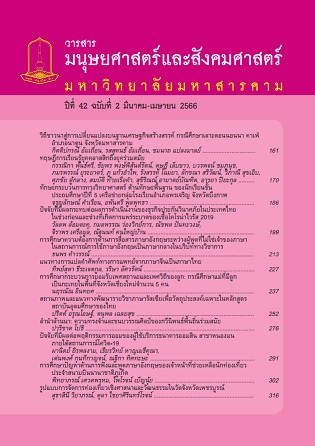การศึกษาความต้องการด้านการสื่อสารภาษาอังกฤษระหว่างผู้พูดที่ไม่ใช่เจ้าของภาษาในสถานการณ์การใช้ภาษาอังกฤษเป็นภาษากลางในบริบททางวิชาการ
Main Article Content
บทคัดย่อ
งานวิจัยเรื่องนี้มุ่งศึกษาปัญหาด้านการสื่อสารภาษาอังกฤษระหว่างผู้พูดที่ไม่ใช่เจ้าของภาษาในสถานการณ์การใช้ภาษาอังกฤษเป็นภาษากลางในบริบททางวิชาการ ประชากรที่ใช้ในการวิจัยครั้งนี้คืออาจารย์ชาวไทย จำนวน 2 คน นักเรียนไทย จำนวน 15 คน นักเรียนกัมพูชา จำนวน 15 คนระดับชั้นมัธยมศึกษาปีที่6 ที่ลงทะเบียนเรียนชั้นเรียนพิเศษในมหาวิทยาลัย ซึ่งนักเรียนทั้งหมดใช้ภาษาอังกฤษเป็นภาษากลางในการสื่อสารในบริบททางวิชาการ ผู้วิจัยเก็บข้อมูลโดยการสัมภาษณ์ และใช้วิธีกำหนดรหัสข้อมูล ในการวิเคราะห์ข้อมูล ผลการวิจัยพบว่านักเรียนชาวไทยและชาวกัมพูชา มีความต้องการด้านการสื่อสารคล้ายกัน 2 อย่างคือ นักเรียนมีความรู้ด้านภาษาอย่างจำกัดซึ่งประกอบด้วยความต้องการการแก้ปัญหาด้านความเข้าใจ การใช้ไวยกรณ์ผิดพลาดรวมถึงการมีความรู้ด้านคำศัพท์จำกัด และ อีกความต้องการคือการมีอคติทางด้านสังคมและวัฒนธรรมจึงทำให้การสื่อสารไม่ประสบผลสำเร็จ
Article Details
เอกสารอ้างอิง
Baker, W. (2015). Researchpractice: Culturalandinterculturalawareness.Language Teaching,48(1), 310-141.
Boonkit, K. (2010). Enhancing the development of speaking skills for non-native speakers of English. Procedia Social and Behavioral Sciences, 2, 1305-1309.
Canagarajah, A. S. (2005). Reclaming the local in language policy and praersey: Laurence Erlbaum Associates, Inc.
Canale, M. (1983). From communicative competence to communicative languagepedagogy. In Richards, J. C., & Schmidt, R. W. (Eds.), Language and Communcation, (pp. ondon:Longman.
Cogo, A. & M. Dewey. (2006). “Efficiency in ELF communication: From pragmatic motives to lexicogrammatical innvation”. Nordic Journal of English Studies, 5, 59-93.
Crystal, D. (2003). English as a global language (2nd ridge: Cambridge University Press.
Dang, L.C. (2016). Intercultural communication: Differences between Western and Asian Perspective. Centria University of Applied Sciences.
Dornyei,Z. (1995). Ontheteachabilityofcommunicationstrategies.TESOL Quarterly, 29,55-85.
Dornyei, Z., & Kormos, J. (1998). Problem-solving mechanisms in L2 communication: A psycholinguistic perspective. Studies in Second Language Acquisition, 20, 349-85.
Doörnyei, Z., & Scott, M. (1995). Communication strategies: An empirical analysis with retrospection. In J.S.Turley & K. Lusby (Eds.) Selected papers from the proceedings of the 21st Annual Symposium of the Deseret Language and Linguistic Society
(p. 155o, UT: Brigham Young University.
Graddol, D. (2006). English next: Why global English may mean the end of ‘English as a Foreign Language: British Council.
Jenkins, J. (2007). English as a Lingua Franca: Attitude and identity. Oxford University Press.
Kasper, G. & Kellerman, E. (1997). Communication strategies: Psycholinguistic and sociolinguistic perspective: Lonman.
Khamkaew, S. (2009). Needs and problems in English listening and speaking skills: A case study of the metropolitan Police Officers at Counter Service at Chana Songkram Policetation [Master’s hngkok: Srinakharinwirot University].
Kiczkowiak, M. (2019). Seven principles for writing materials for English as a lingua franca.ELT Journal, 74(1), 1–9.
Kirkpatrick, A. (2010). English as a Lingua Franca in ASEAN: A multilingual kong. Hong Kong University Press.
Kohn, K. (2020). A pedagogical lingua franca approach: Emancipating the foreign language learner. LEARN Journal: Language Education and Acquisition Research Network,13(2), 1-14.
Kongsom,T. (2009).The effects of teaching communication strategies on Thai learners of nglish.[Doctoral dissertation, University of Southampton].
Leung, K. Y A, Lee, S-I., & Chiu, C-Y. (2013). Meta-knowledge of culture promotes cultural competence. Journal of Cross-Cultural Psychology, 44(6), 992-1006.
Long, M. H (1983a). Native speaker/non-native speaker conversation and the negotiation of comprehensible input. Applied Linguistics, 4(2), 126-141.
Nguyen, M. X. N. C. (2017).TESOL teachers’ engagement with the native speaker model: How does teacher education impact on their beliefs?. RELC Journal, 48(1), 83-98.
Saldana, J. (2009). Coding Manual for qualitative researchers. Sage.
Seidlhofer, B. (2001). Closingaconceptualgap:Thecaseforadescriptionof Englishasalingua franca. International Journal of Applied Linguistics, 11, 134-158.
Seidlhofer, B. (2005). English as a lingua franca. ELT Journal, 59, 339-341.
Seidlhofer, B. (2008). Ofnormsand mindsets. Australian Review of Applied Linguistics, 3(1),1-7.
Seidlhofer, B. (2011). Understanding ELF. Oxford University Press.
Sifakis, N. C. (2014). ELFawarenessasanopportunity for change: A transformativeperspective for TESOL teacher education. Journal of English as a Lingua Franca, 3(2), 315-333.
Suwannasom, T.(2019). A Study on intercultural strategies in English as a lingua franca communication of Naresuan University graduate students. Journal of Liberal Arts, Prince of Songkla University, 11(1), 307-337.
Walker, R. (2001). Pronunciation priorities, the Lingua Franca care, and monolingual groups. Newsletters of the IATEFL Pronunciation Special Interest Group, 28, 4-9.
riyajchitra, A. (2002). English language teaching and learning in Thailand in this decade. Thai TESOL Focus, 15(1), 4-9.


